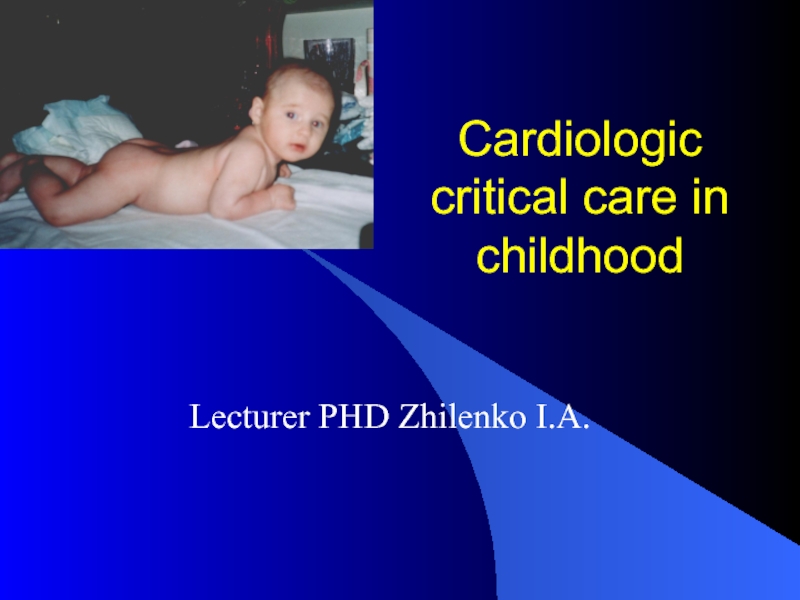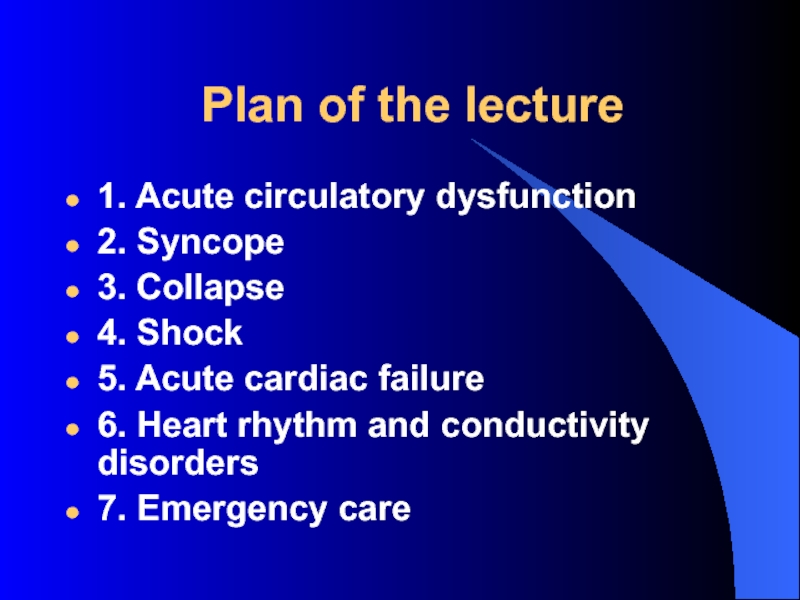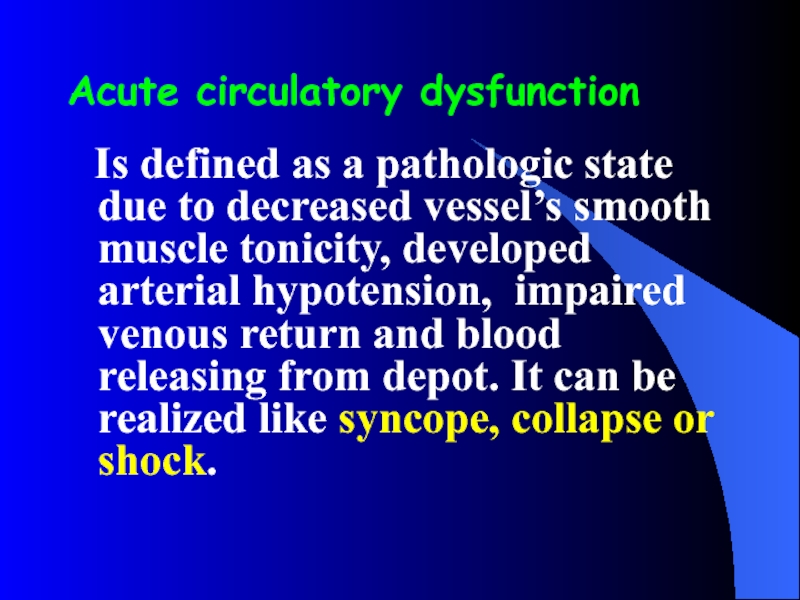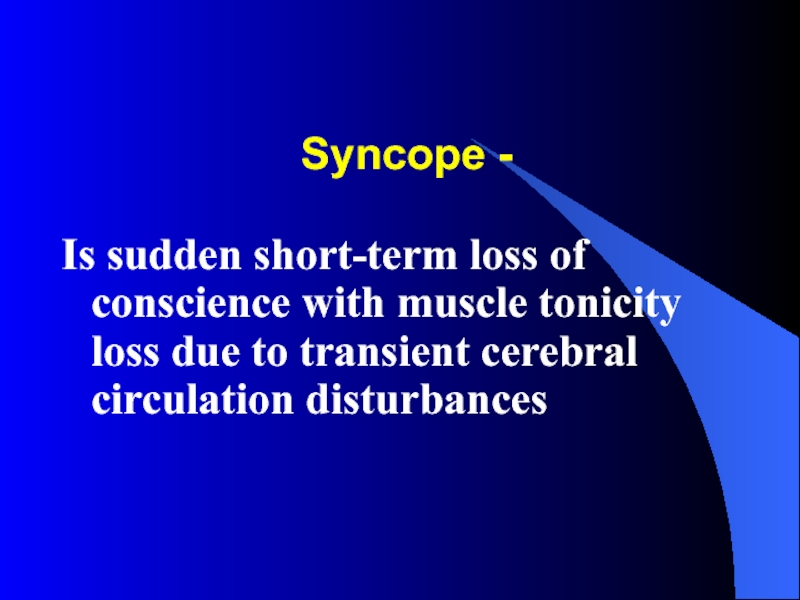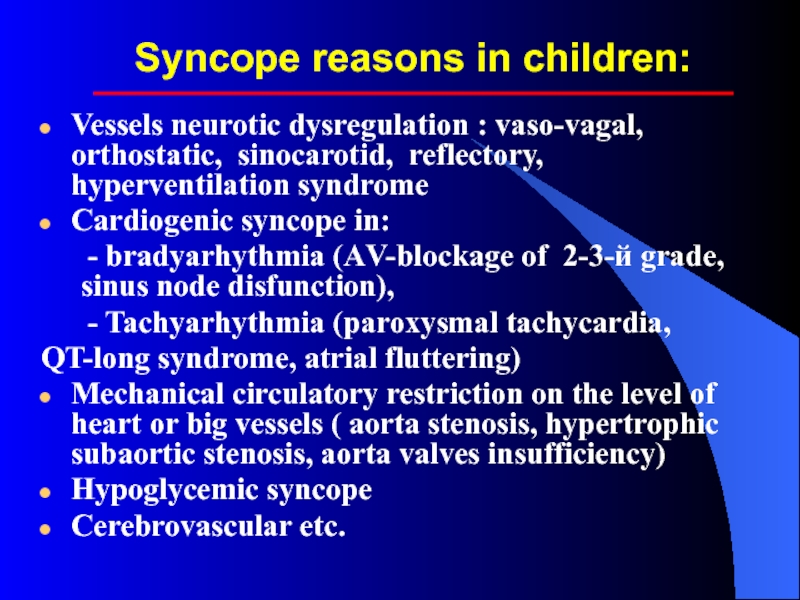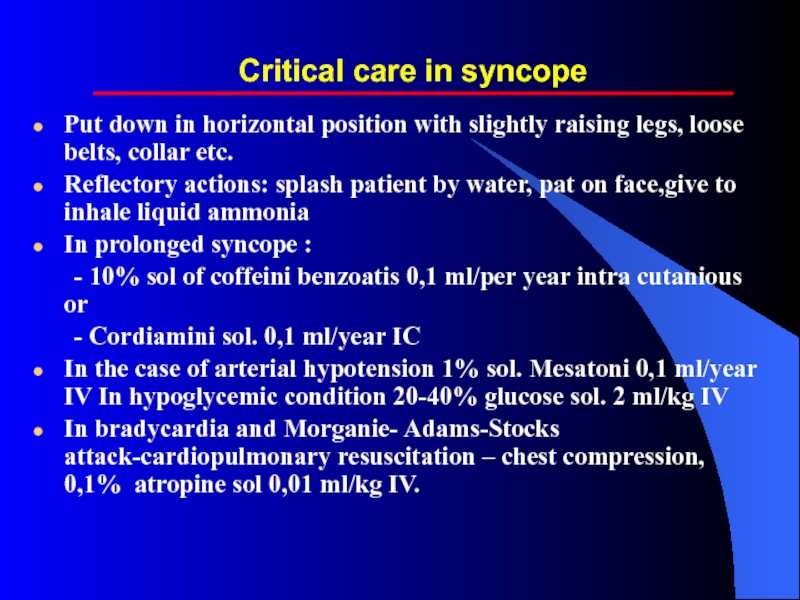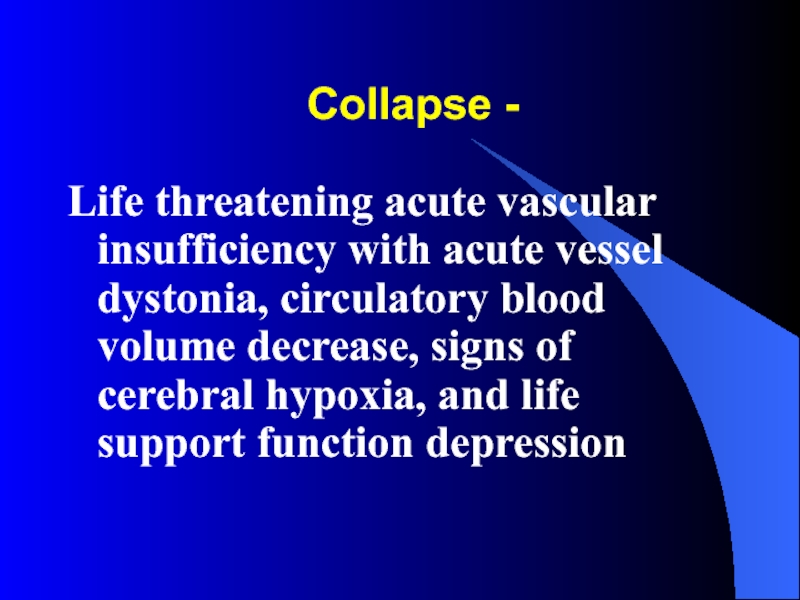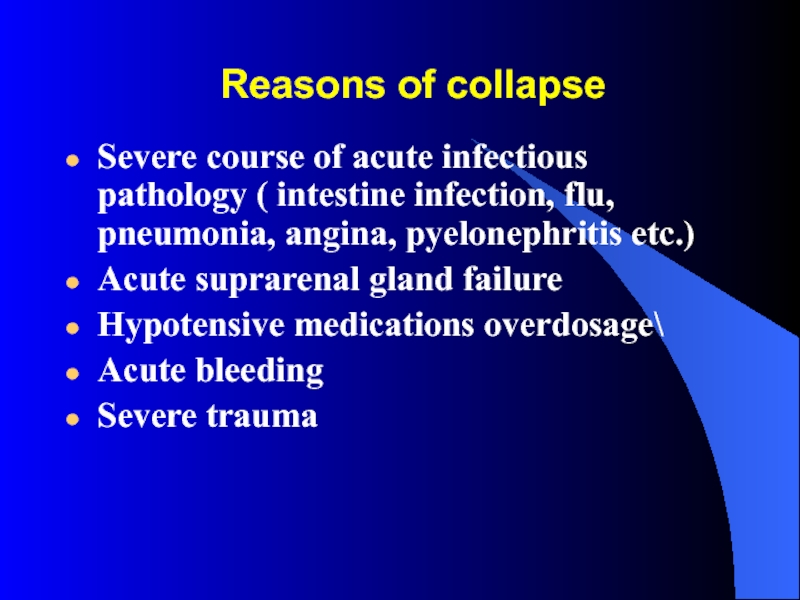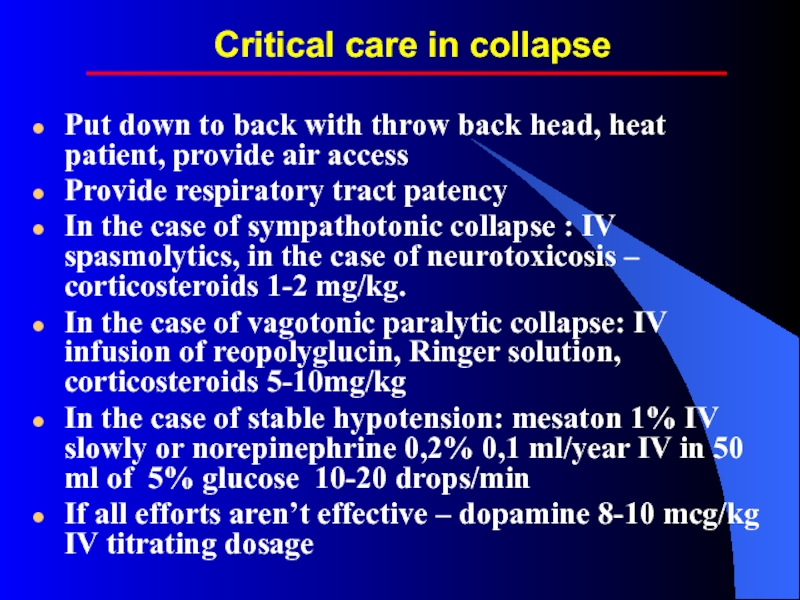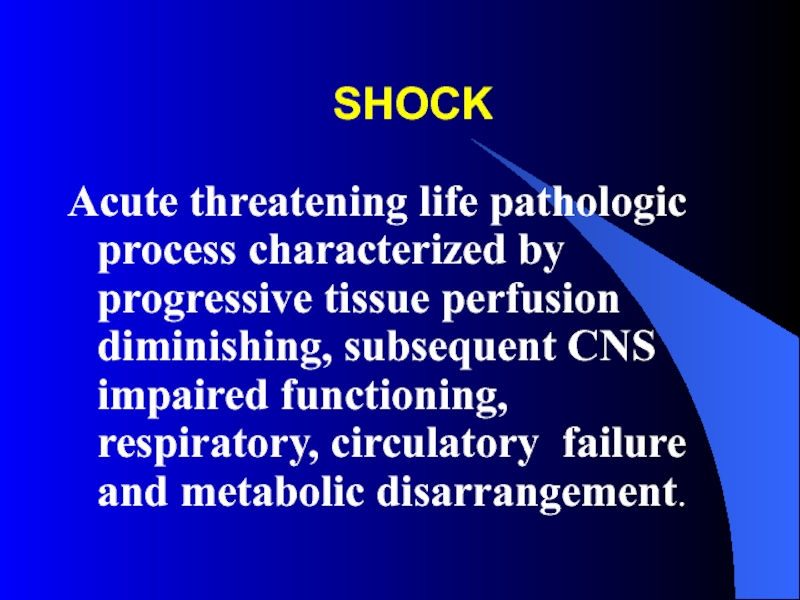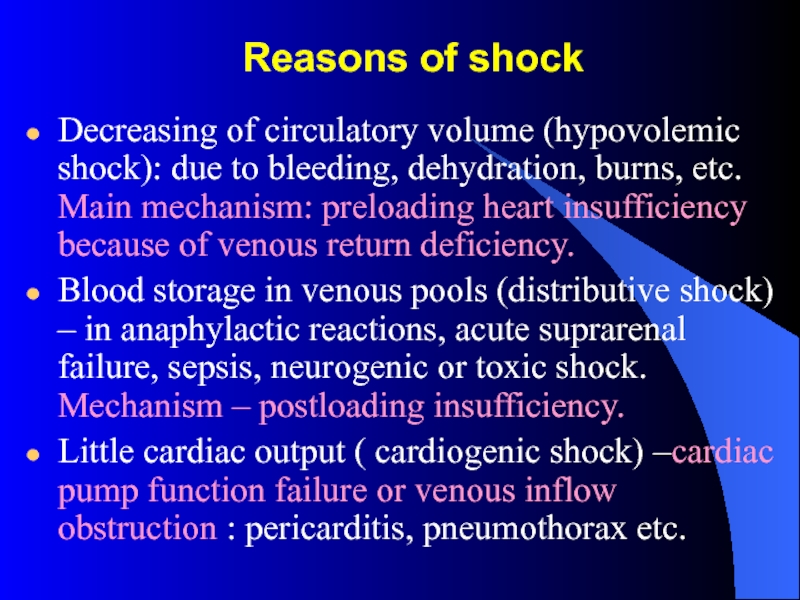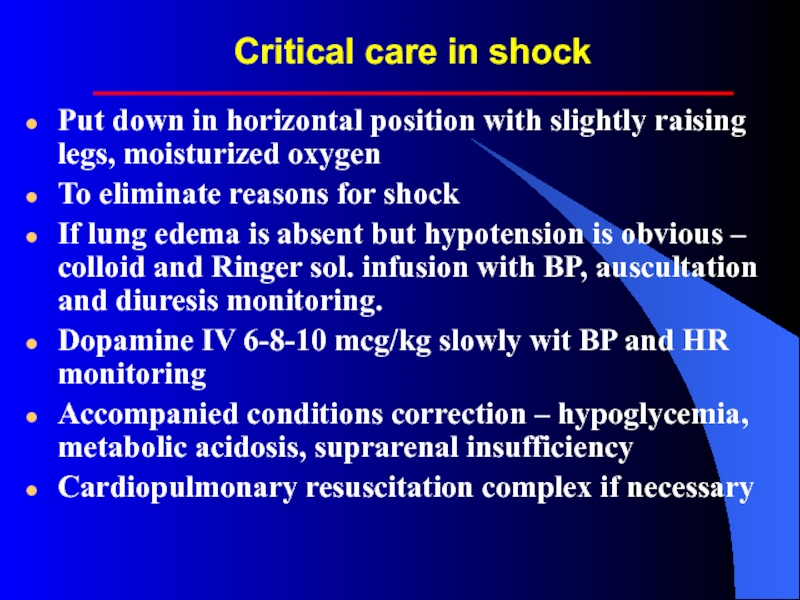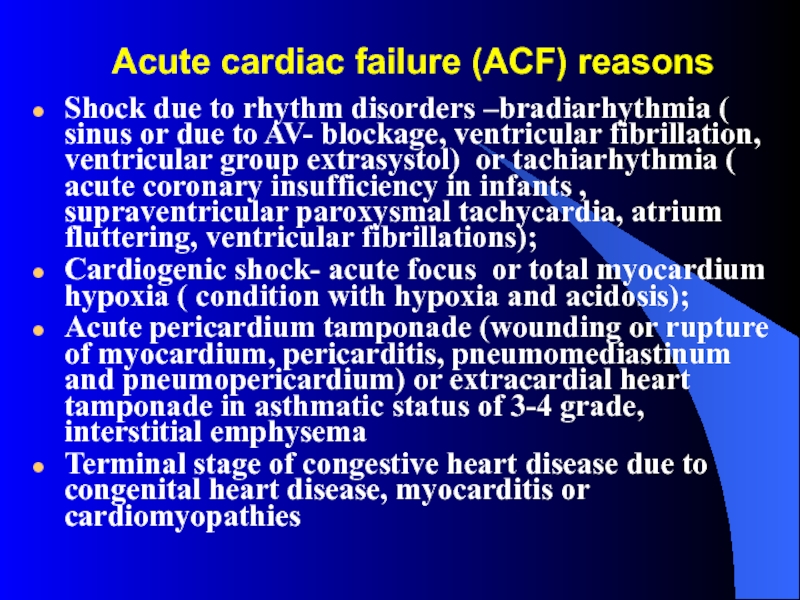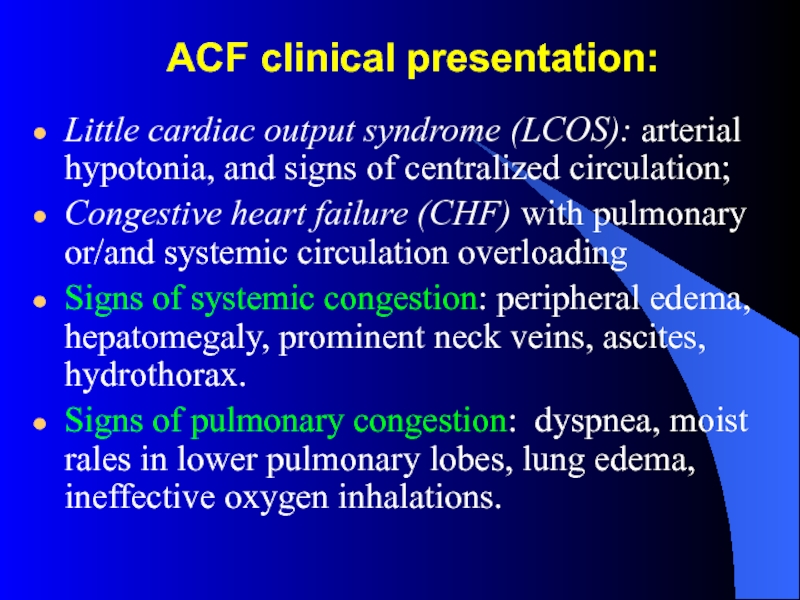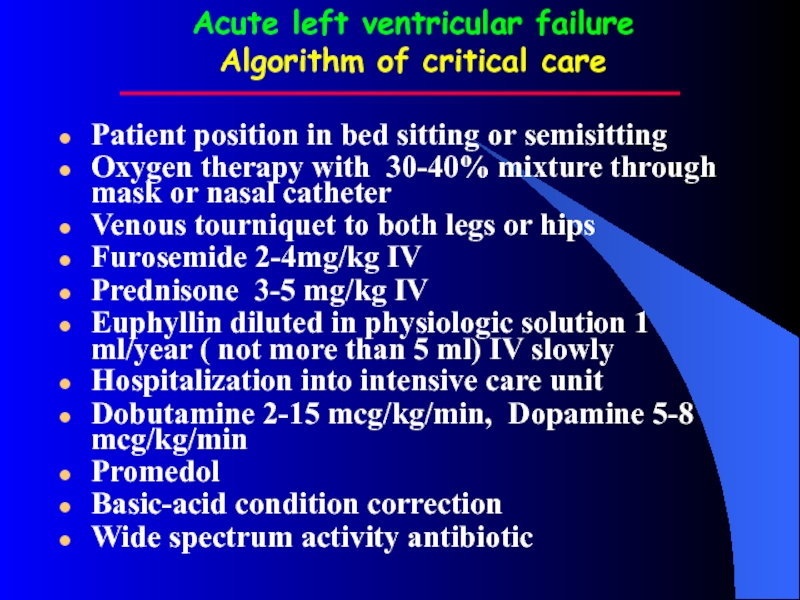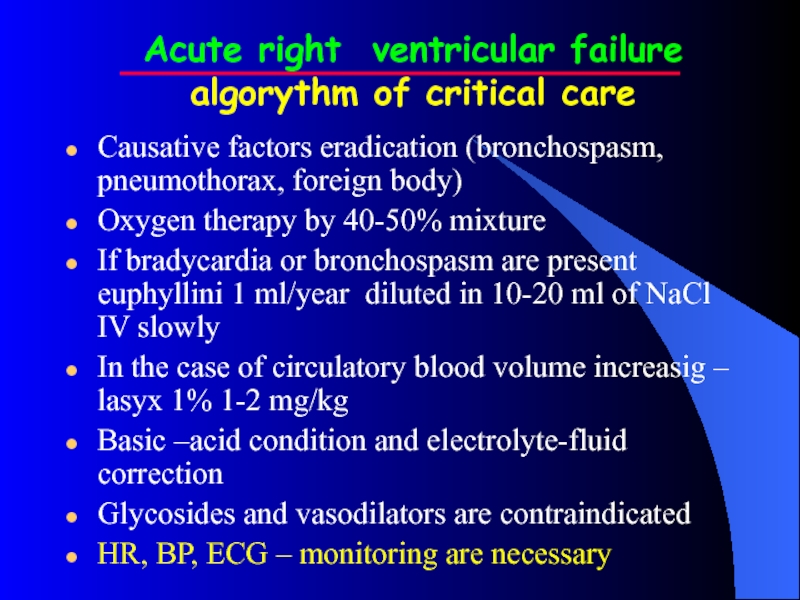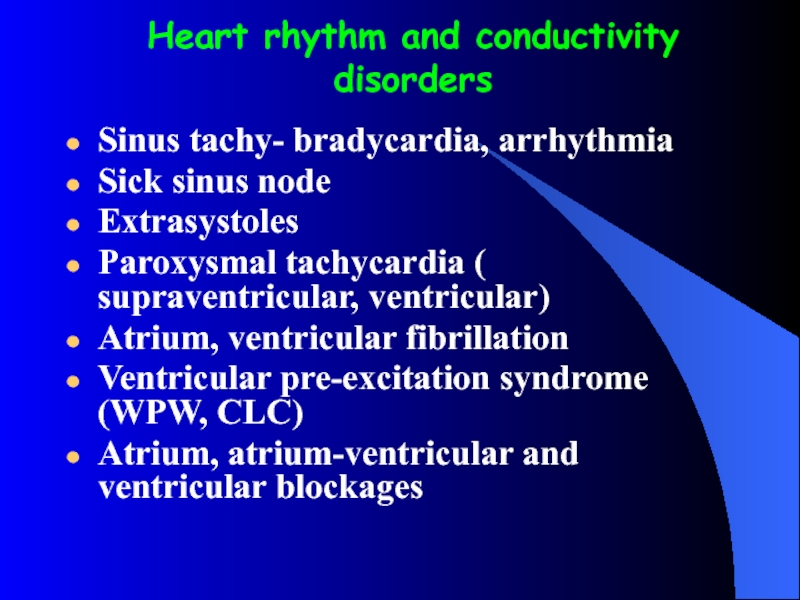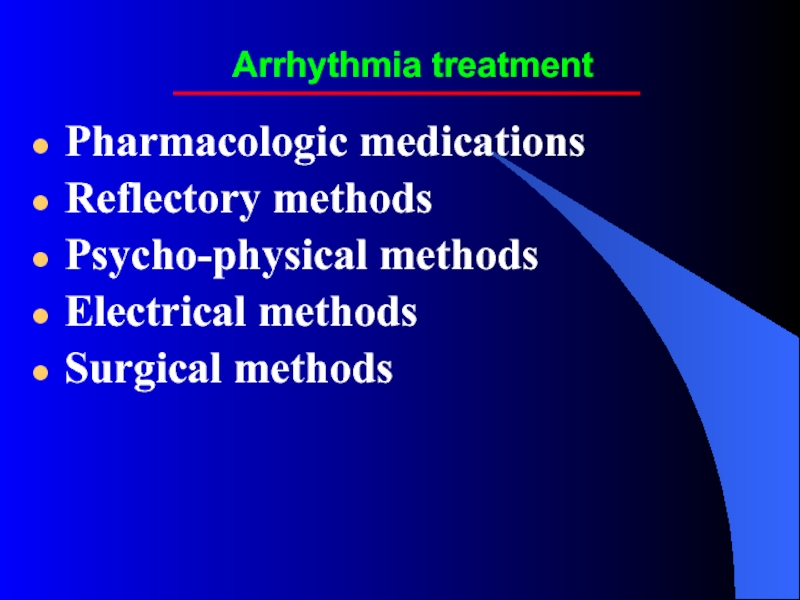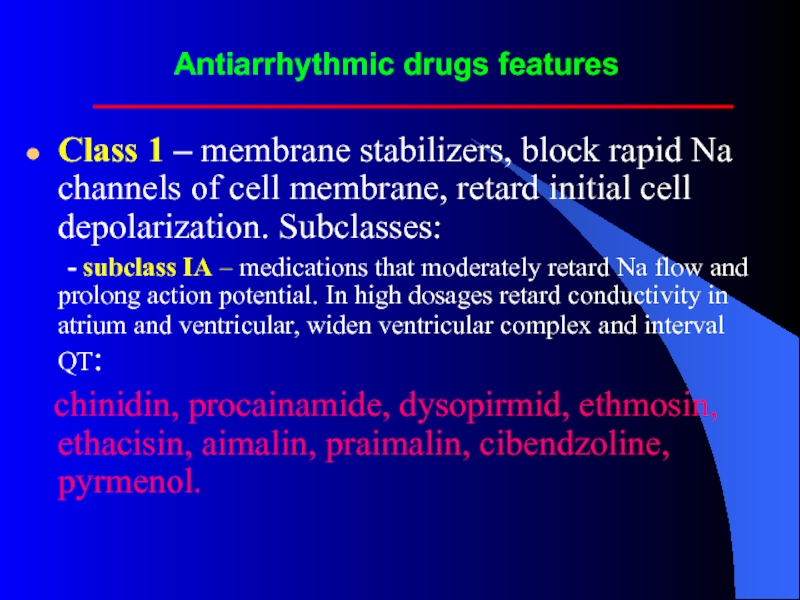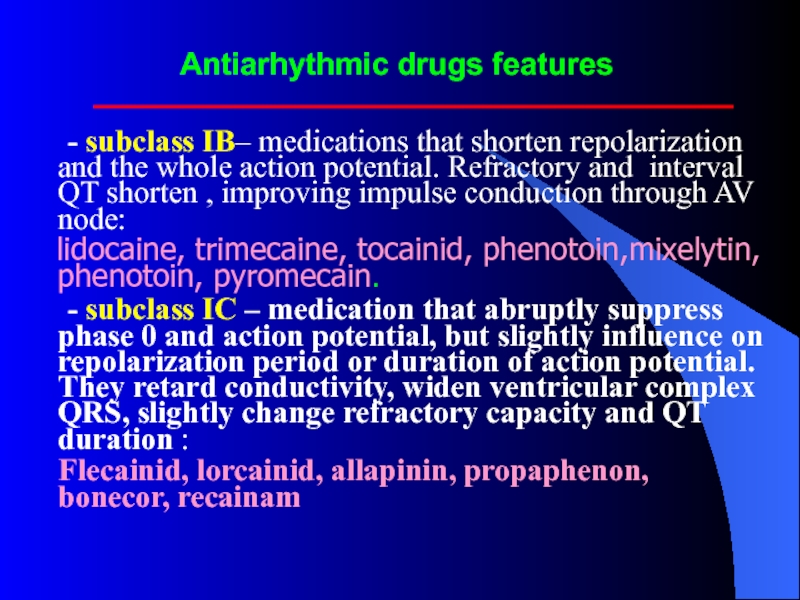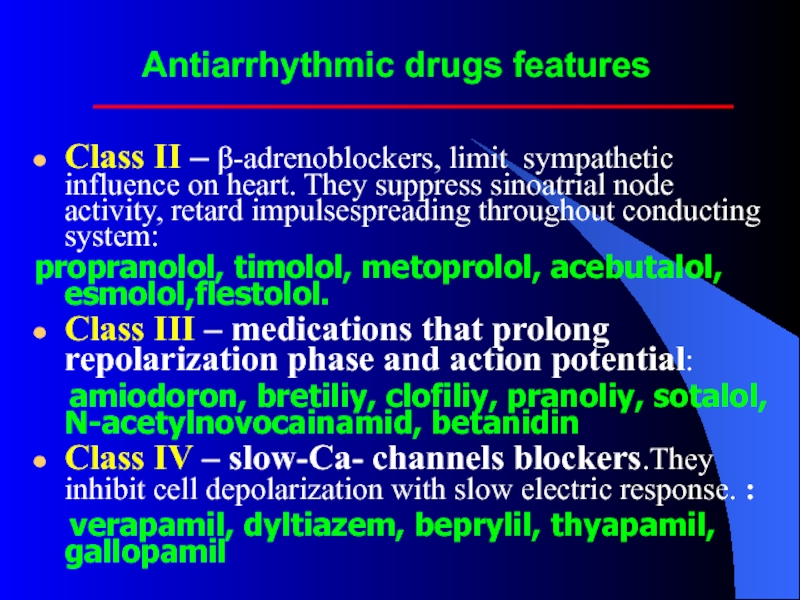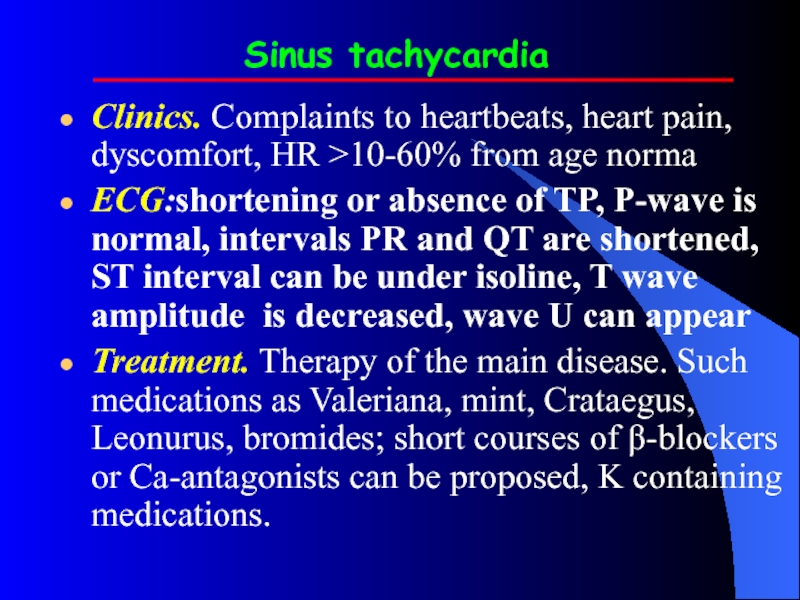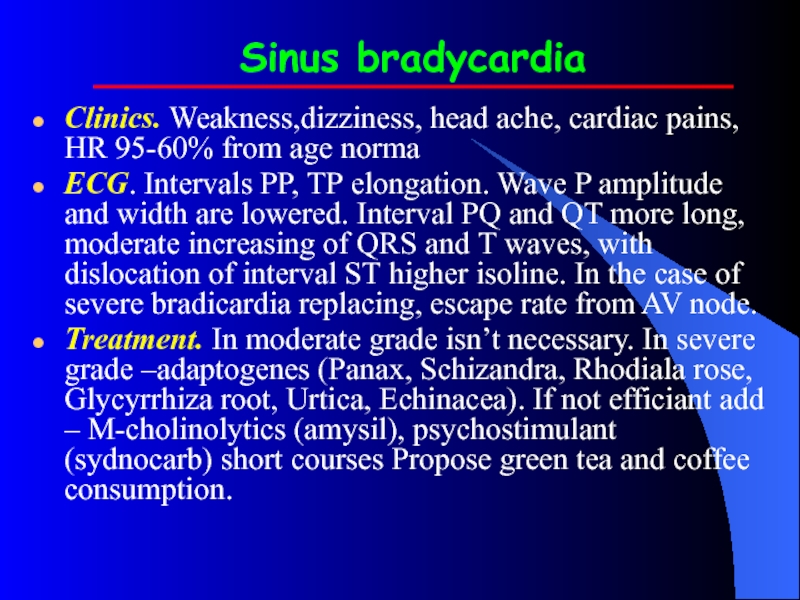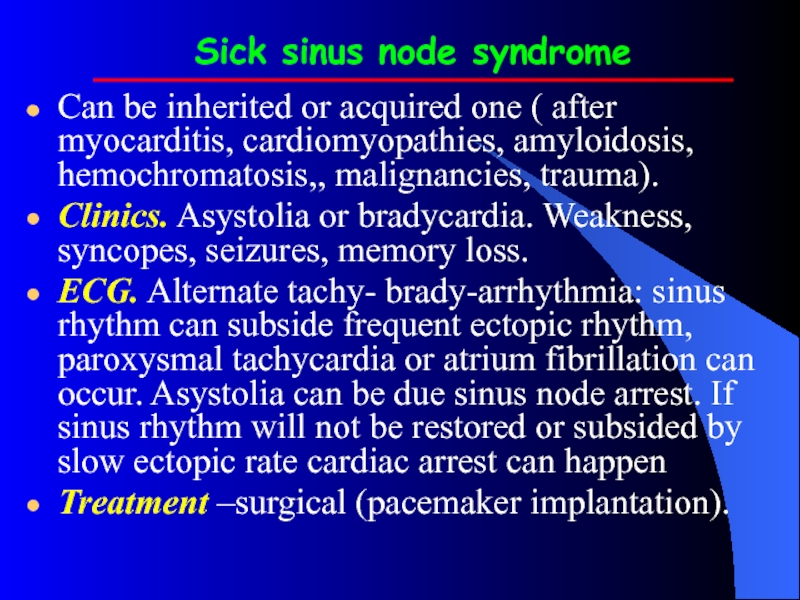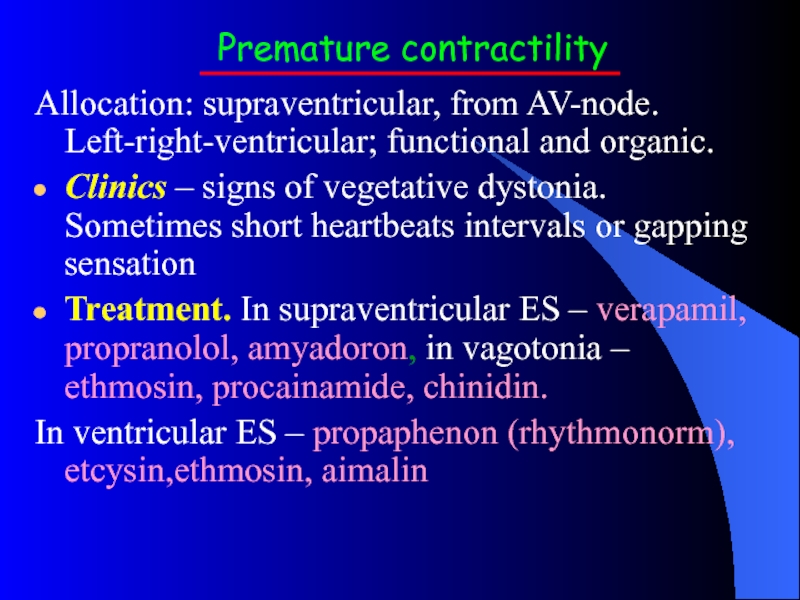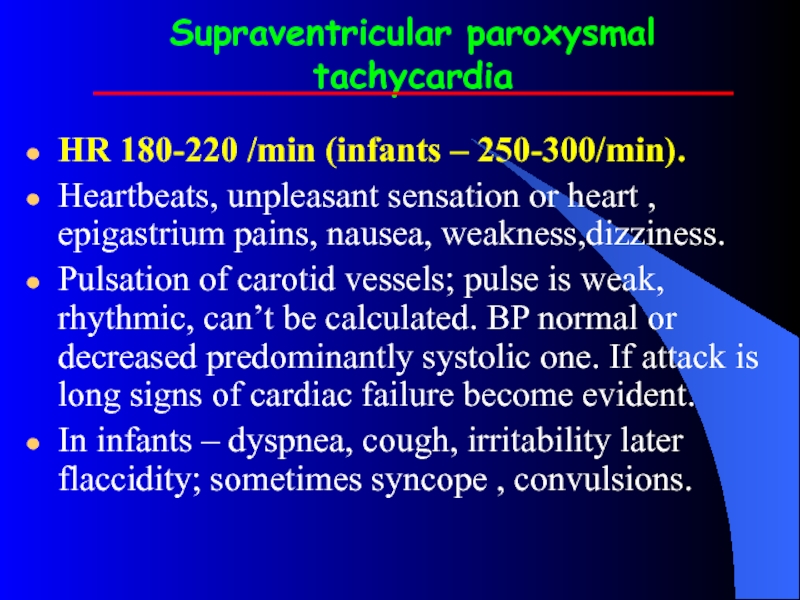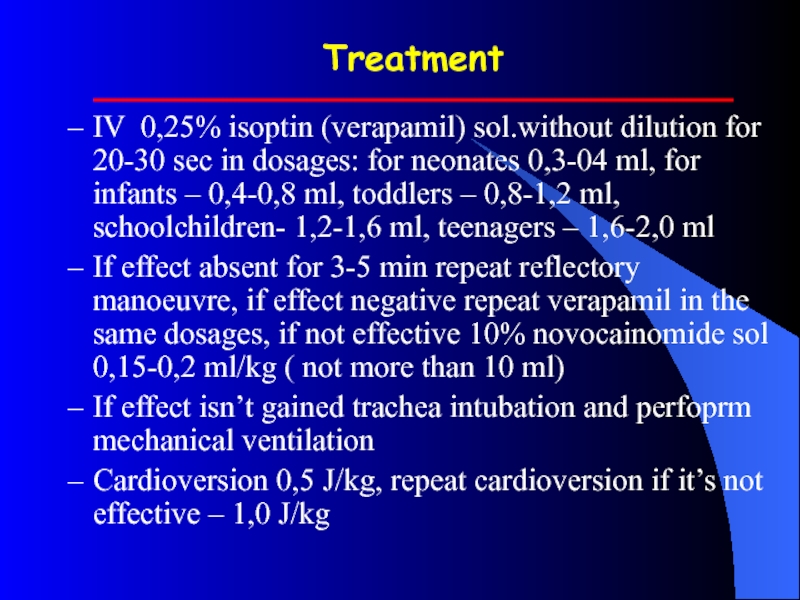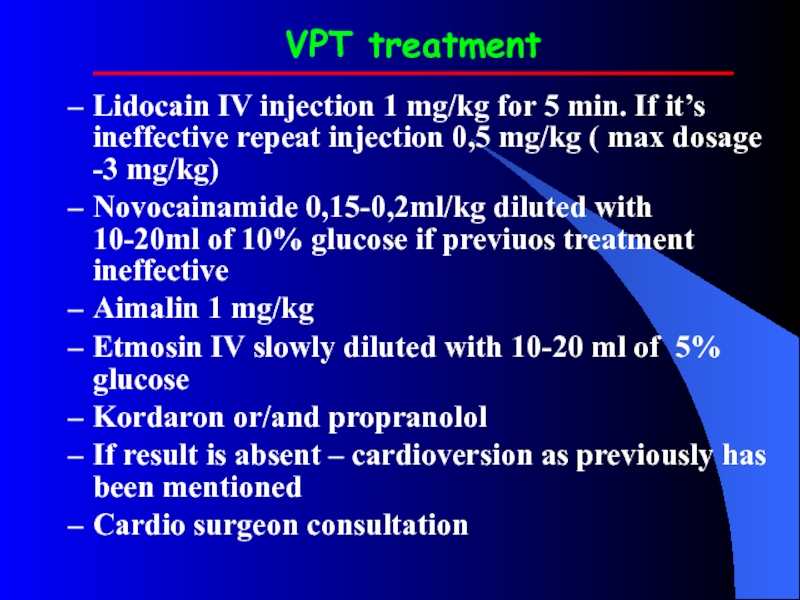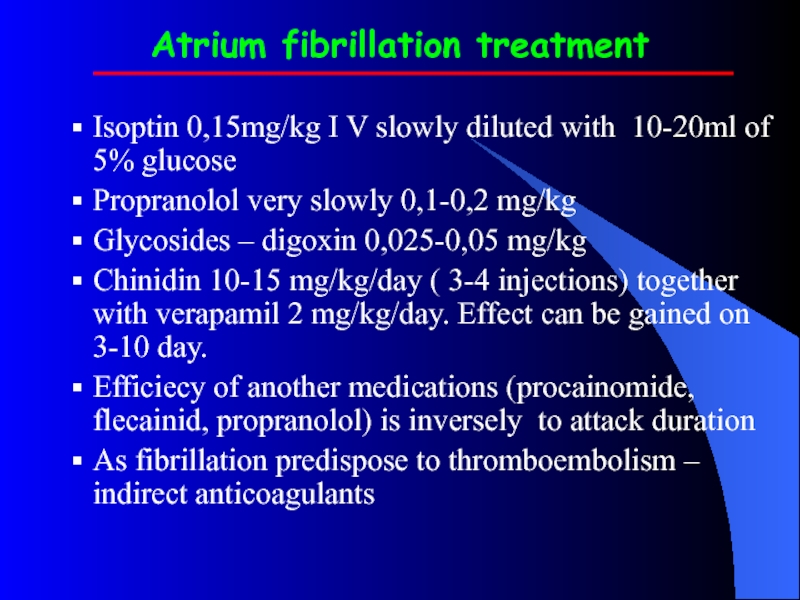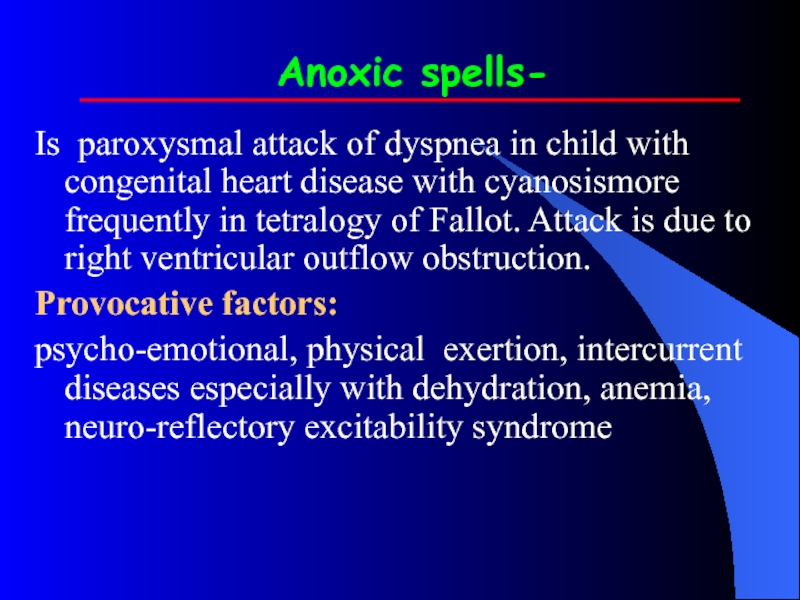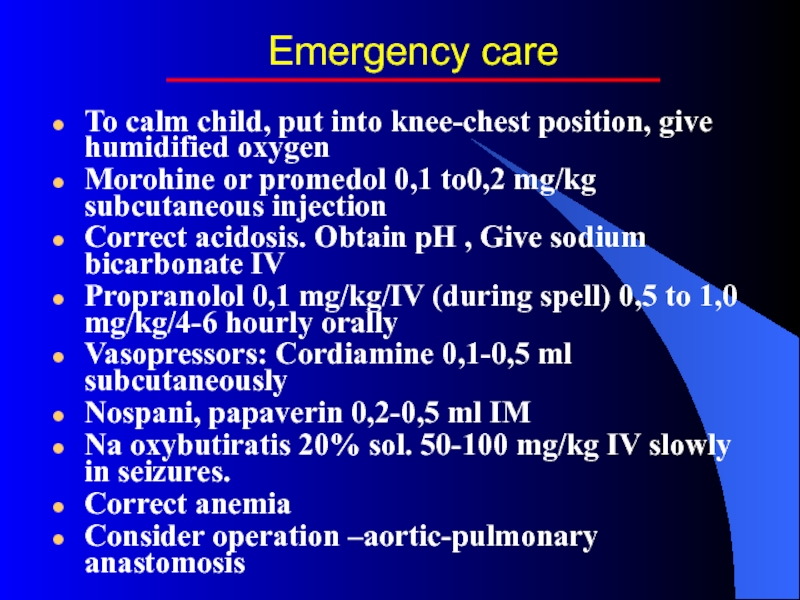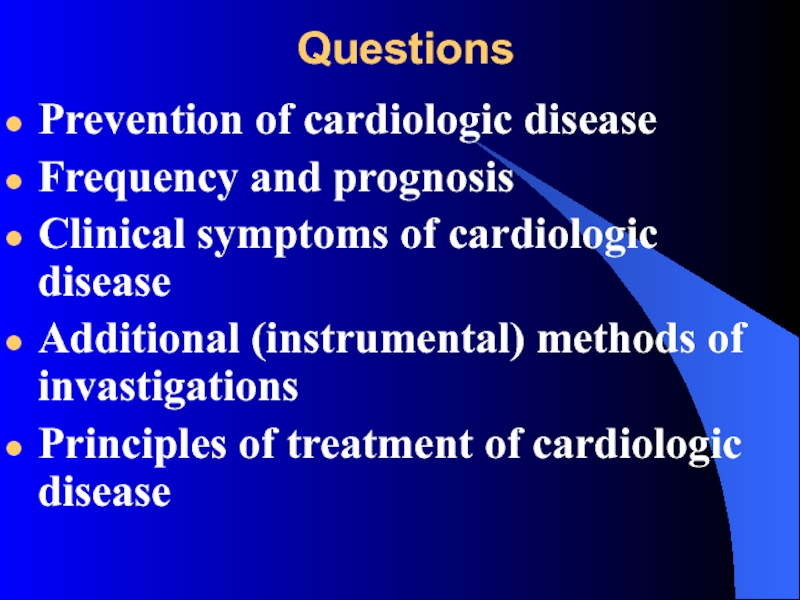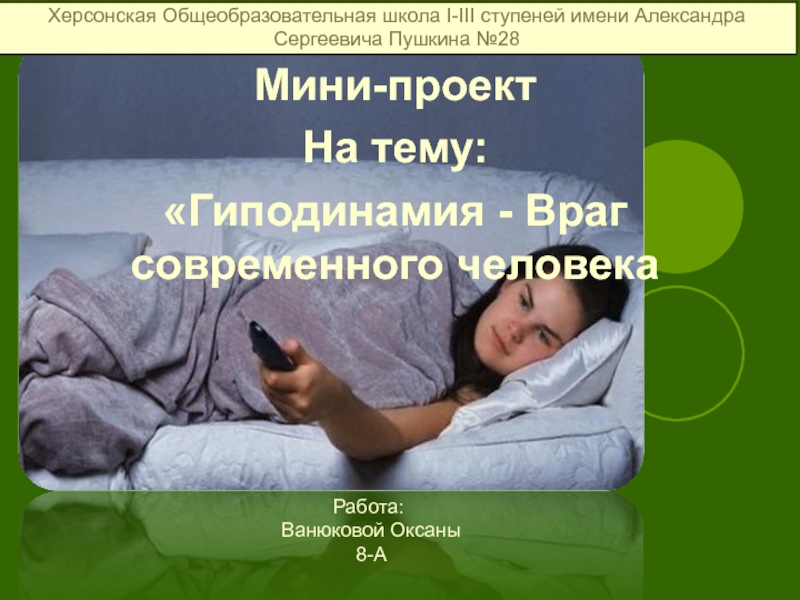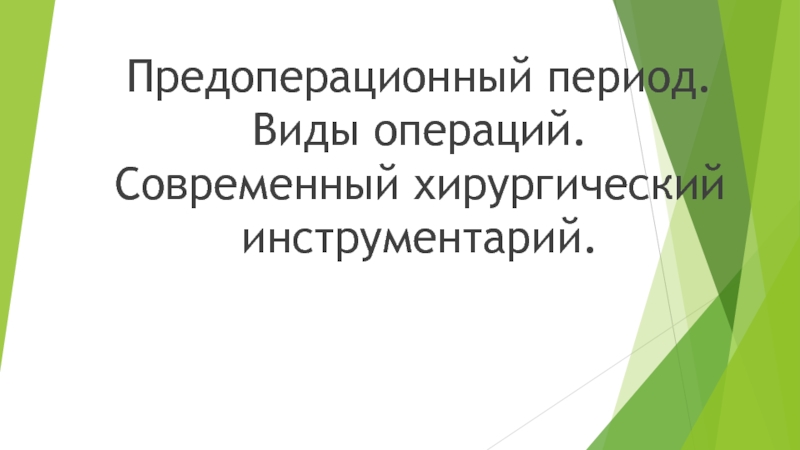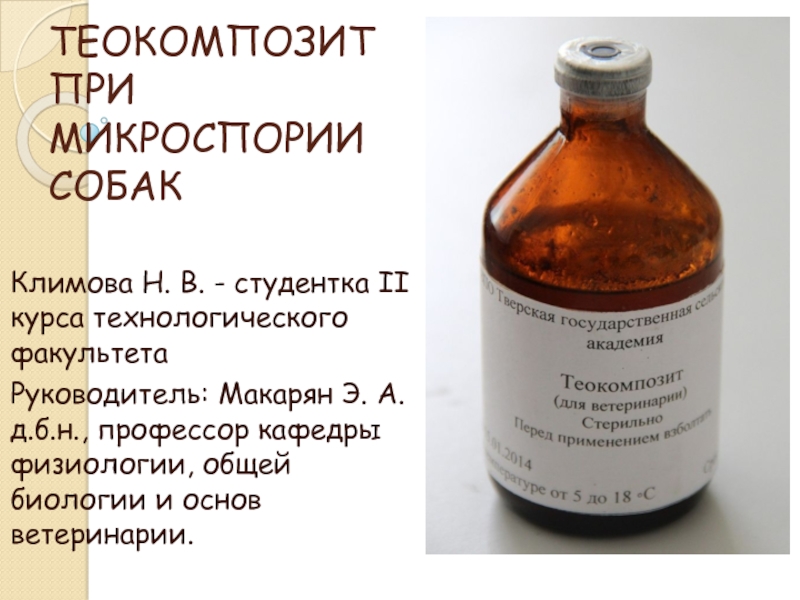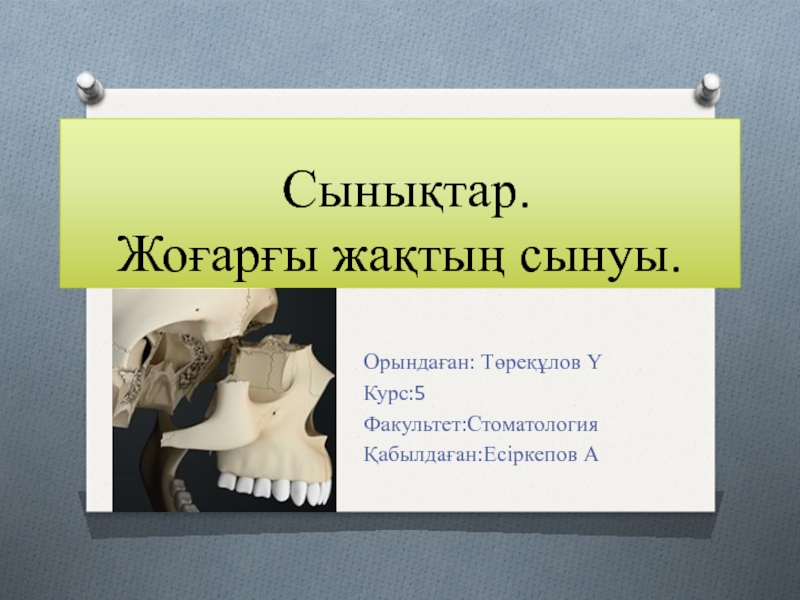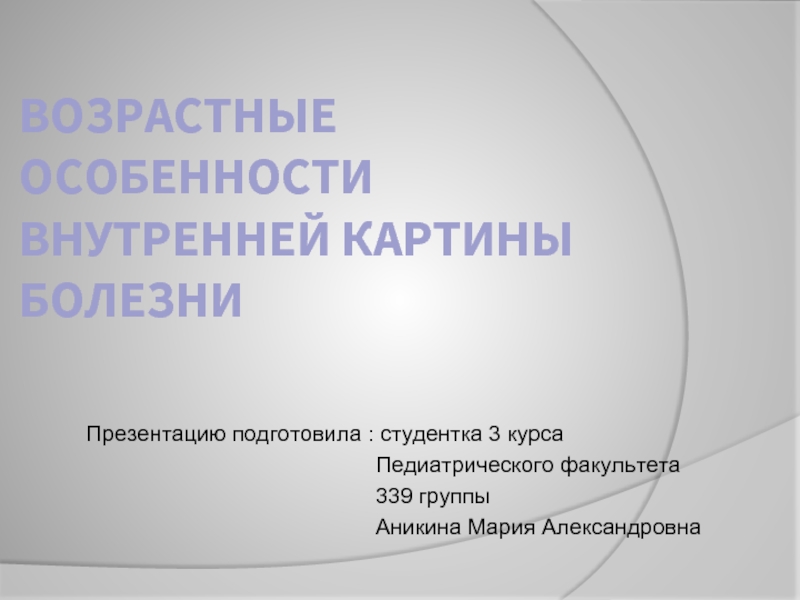- Главная
- Разное
- Дизайн
- Бизнес и предпринимательство
- Аналитика
- Образование
- Развлечения
- Красота и здоровье
- Финансы
- Государство
- Путешествия
- Спорт
- Недвижимость
- Армия
- Графика
- Культурология
- Еда и кулинария
- Лингвистика
- Английский язык
- Астрономия
- Алгебра
- Биология
- География
- Детские презентации
- Информатика
- История
- Литература
- Маркетинг
- Математика
- Медицина
- Менеджмент
- Музыка
- МХК
- Немецкий язык
- ОБЖ
- Обществознание
- Окружающий мир
- Педагогика
- Русский язык
- Технология
- Физика
- Философия
- Химия
- Шаблоны, картинки для презентаций
- Экология
- Экономика
- Юриспруденция
Cardiologic critical care in childhood презентация
Содержание
- 1. Cardiologic critical care in childhood
- 2. Plan of the lecture 1. Acute
- 3. Acute circulatory dysfunction Is defined
- 4. Syncope - Is sudden short-term loss
- 5. Syncope reasons in children: Vessels neurotic dysregulation
- 6. Critical care in syncope Put down in
- 7. Collapse - Life threatening acute vascular insufficiency
- 8. Reasons of collapse Severe course of acute
- 9. Critical care in collapse Put down to
- 10. SHOCK Acute threatening life pathologic process
- 11. Reasons of shock Decreasing of circulatory volume
- 12. Critical care in shock Put down in
- 13. Acute cardiac failure Pathologic condition characterized by
- 14. Acute cardiac failure (ACF) reasons Shock due
- 15. ACF reasons: Acute lung and bronchial disorders
- 16. ACF clinical presentation: Little cardiac output syndrome
- 17. Acute left ventricular failure Algorithm of
- 18. Acute right ventricular failure algorythm of critical
- 19. Heart rhythm and conductivity disorders Sinus tachy-
- 20. Arrhythmia treatment Pharmacologic medications Reflectory methods Psycho-physical methods Electrical methods Surgical methods
- 21. Antiarrhythmic drugs features Class 1 – membrane
- 22. Antiarhythmic drugs features - subclass IВ– medications
- 23. Antiarrhythmic drugs features Class II – β-adrenoblockers,
- 24. Sinus tachycardia Clinics. Complaints to heartbeats, heart
- 25. Sinus bradycardia Clinics. Weakness,dizziness, head ache, cardiac
- 26. Sick sinus node syndrome Can be inherited
- 27. Premature contractility Allocation: supraventricular, from AV-node. Left-right-ventricular;
- 28. Supraventricular paroxysmal tachycardia HR 180-220 /min (infants
- 29. Treatment Semisitting position, respiratory therapy Mechanical stimulation
- 30. Treatment IV 0,25% isoptin (verapamil) sol.without dilution
- 31. Ventricular paroxysmal tachycardia (VPT) Abrupt heartbeating attack,
- 32. VPT treatment Lidocain IV injection 1 mg/kg
- 33. Atrium fibrillation treatment Isoptin 0,15mg/kg I V
- 34. Anoxic spells- Is paroxysmal attack of
- 35. Clinical presentation Sudden onset Irritability, moaning, crying
- 36. Emergency care To calm child, put into
- 37. Questions Prevention of cardiologic disease
Слайд 2Plan of the lecture
1. Acute circulatory dysfunction
2. Syncope
3. Collapse
4. Shock
5. Acute cardiac failure
6. Heart rhythm and conductivity disorders
7. Emergency care
Слайд 3Acute circulatory dysfunction
Is defined as a pathologic state due
to decreased vessel’s smooth muscle tonicity, developed arterial hypotension, impaired venous return and blood releasing from depot. It can be realized like syncope, collapse or shock.
Слайд 4Syncope -
Is sudden short-term loss of conscience with muscle tonicity
loss due to transient cerebral circulation disturbances
Слайд 5Syncope reasons in children:
Vessels neurotic dysregulation : vaso-vagal, orthostatic, sinocarotid, reflectory,
hyperventilation syndrome
Cardiogenic syncope in:
- bradyarhythmia (АV-blockage of 2-3-й grade, sinus node disfunction),
- Tachyarhythmia (paroxysmal tachycardia,
QT-long syndrome, atrial fluttering)
Mechanical circulatory restriction on the level of heart or big vessels ( aorta stenosis, hypertrophic subaortic stenosis, aorta valves insufficiency)
Hypoglycemic syncope
Cerebrovascular etc.
Cardiogenic syncope in:
- bradyarhythmia (АV-blockage of 2-3-й grade, sinus node disfunction),
- Tachyarhythmia (paroxysmal tachycardia,
QT-long syndrome, atrial fluttering)
Mechanical circulatory restriction on the level of heart or big vessels ( aorta stenosis, hypertrophic subaortic stenosis, aorta valves insufficiency)
Hypoglycemic syncope
Cerebrovascular etc.
Слайд 6Critical care in syncope
Put down in horizontal position with slightly raising
legs, loose belts, collar etc.
Reflectory actions: splash patient by water, pat on face,give to inhale liquid ammonia
In prolonged syncope :
- 10% sol of coffeini benzoatis 0,1 ml/per year intra cutanious or
- Cordiamini sol. 0,1 ml/year IC
In the case of arterial hypotension 1% sol. Mesatoni 0,1 ml/year IV In hypoglycemic condition 20-40% glucose sol. 2 ml/kg IV
In bradycardia and Morganie- Adams-Stocks attack-cardiopulmonary resuscitation – chest compression, 0,1% atropine sol 0,01 ml/kg IV.
Reflectory actions: splash patient by water, pat on face,give to inhale liquid ammonia
In prolonged syncope :
- 10% sol of coffeini benzoatis 0,1 ml/per year intra cutanious or
- Cordiamini sol. 0,1 ml/year IC
In the case of arterial hypotension 1% sol. Mesatoni 0,1 ml/year IV In hypoglycemic condition 20-40% glucose sol. 2 ml/kg IV
In bradycardia and Morganie- Adams-Stocks attack-cardiopulmonary resuscitation – chest compression, 0,1% atropine sol 0,01 ml/kg IV.
Слайд 7Collapse -
Life threatening acute vascular insufficiency with acute vessel dystonia, circulatory
blood volume decrease, signs of cerebral hypoxia, and life support function depression
Слайд 8Reasons of collapse
Severe course of acute infectious pathology ( intestine infection,
flu, pneumonia, angina, pyelonephritis etc.)
Acute suprarenal gland failure
Hypotensive medications overdosage\
Acute bleeding
Severe trauma
Acute suprarenal gland failure
Hypotensive medications overdosage\
Acute bleeding
Severe trauma
Слайд 9Critical care in collapse
Put down to back with throw back head,
heat patient, provide air access
Provide respiratory tract patency
In the case of sympathotonic collapse : IV spasmolytics, in the case of neurotoxicosis – corticosteroids 1-2 mg/kg.
In the case of vagotonic paralytic collapse: IV infusion of reopolyglucin, Ringer solution, corticosteroids 5-10mg/kg
In the case of stable hypotension: mesaton 1% IV slowly or norepinephrine 0,2% 0,1 ml/year IV in 50 ml of 5% glucose 10-20 drops/min
If all efforts aren’t effective – dopamine 8-10 mcg/kg IV titrating dosage
Provide respiratory tract patency
In the case of sympathotonic collapse : IV spasmolytics, in the case of neurotoxicosis – corticosteroids 1-2 mg/kg.
In the case of vagotonic paralytic collapse: IV infusion of reopolyglucin, Ringer solution, corticosteroids 5-10mg/kg
In the case of stable hypotension: mesaton 1% IV slowly or norepinephrine 0,2% 0,1 ml/year IV in 50 ml of 5% glucose 10-20 drops/min
If all efforts aren’t effective – dopamine 8-10 mcg/kg IV titrating dosage
Слайд 10SHOCK
Acute threatening life pathologic process characterized by progressive tissue perfusion
diminishing, subsequent CNS impaired functioning, respiratory, circulatory failure and metabolic disarrangement.
Слайд 11Reasons of shock
Decreasing of circulatory volume (hypovolemic shock): due to bleeding,
dehydration, burns, etc. Main mechanism: preloading heart insufficiency because of venous return deficiency.
Blood storage in venous pools (distributive shock) – in anaphylactic reactions, acute suprarenal failure, sepsis, neurogenic or toxic shock. Mechanism – postloading insufficiency.
Little cardiac output ( cardiogenic shock) –cardiac pump function failure or venous inflow obstruction : pericarditis, pneumothorax etc.
Blood storage in venous pools (distributive shock) – in anaphylactic reactions, acute suprarenal failure, sepsis, neurogenic or toxic shock. Mechanism – postloading insufficiency.
Little cardiac output ( cardiogenic shock) –cardiac pump function failure or venous inflow obstruction : pericarditis, pneumothorax etc.
Слайд 12Critical care in shock
Put down in horizontal position with slightly raising
legs, moisturized oxygen
To eliminate reasons for shock
If lung edema is absent but hypotension is obvious – colloid and Ringer sol. infusion with BP, auscultation and diuresis monitoring.
Dopamine IV 6-8-10 mcg/kg slowly wit BP and HR monitoring
Accompanied conditions correction – hypoglycemia, metabolic acidosis, suprarenal insufficiency
Cardiopulmonary resuscitation complex if necessary
To eliminate reasons for shock
If lung edema is absent but hypotension is obvious – colloid and Ringer sol. infusion with BP, auscultation and diuresis monitoring.
Dopamine IV 6-8-10 mcg/kg slowly wit BP and HR monitoring
Accompanied conditions correction – hypoglycemia, metabolic acidosis, suprarenal insufficiency
Cardiopulmonary resuscitation complex if necessary
Слайд 13Acute cardiac failure
Pathologic condition characterized by cardiac output decreasing due to
myocardial pumping function reduction or impairment of diastolic myocardial relaxation
Слайд 14Acute cardiac failure (ACF) reasons
Shock due to rhythm disorders –bradiarhythmia (
sinus or due to AV- blockage, ventricular fibrillation, ventricular group extrasystol) or tachiarhythmia ( acute coronary insufficiency in infants , supraventricular paroxysmal tachycardia, atrium fluttering, ventricular fibrillations);
Cardiogenic shock- acute focus or total myocardium hypoxia ( condition with hypoxia and acidosis);
Acute pericardium tamponade (wounding or rupture of myocardium, pericarditis, pneumomediastinum and pneumopericardium) or extracardial heart tamponade in asthmatic status of 3-4 grade, interstitial emphysema
Terminal stage of congestive heart disease due to congenital heart disease, myocarditis or cardiomyopathies
Cardiogenic shock- acute focus or total myocardium hypoxia ( condition with hypoxia and acidosis);
Acute pericardium tamponade (wounding or rupture of myocardium, pericarditis, pneumomediastinum and pneumopericardium) or extracardial heart tamponade in asthmatic status of 3-4 grade, interstitial emphysema
Terminal stage of congestive heart disease due to congenital heart disease, myocarditis or cardiomyopathies
Слайд 15ACF reasons:
Acute lung and bronchial disorders (pneumonia, atelectasis, hydro- and pneumothorax
etc.) Main mechanism of ACF is hypoxia, and lung hypertension due to intrapulmonic circulatory blood shunt.
Any conditions accompanied by tissue hypoxia: toxicosis, syndrome of systemic inflammation, burning disease, severe purulent-inflammatory diseases, i.e. conditions with excessive catabolism where oxygen , glucose necessity are not covered by circulation. In these situations minute blood volume (MBV) necessity rises predominantly due to increased HR. Raised loading to myocardium demand more oxygen but diastole decreases so from one side it decreases ventricular filling and reduce cardiac output and from another side coronary circulation is decreased that cause myocardium ischemia and contractility decreasing.
Any conditions accompanied by tissue hypoxia: toxicosis, syndrome of systemic inflammation, burning disease, severe purulent-inflammatory diseases, i.e. conditions with excessive catabolism where oxygen , glucose necessity are not covered by circulation. In these situations minute blood volume (MBV) necessity rises predominantly due to increased HR. Raised loading to myocardium demand more oxygen but diastole decreases so from one side it decreases ventricular filling and reduce cardiac output and from another side coronary circulation is decreased that cause myocardium ischemia and contractility decreasing.
Слайд 16ACF clinical presentation:
Little cardiac output syndrome (LCOS): arterial hypotonia, and signs
of centralized circulation;
Congestive heart failure (CHF) with pulmonary or/and systemic circulation overloading
Signs of systemic congestion: peripheral edema, hepatomegaly, prominent neck veins, ascites, hydrothorax.
Signs of pulmonary congestion: dyspnea, moist rales in lower pulmonary lobes, lung edema, ineffective oxygen inhalations.
Congestive heart failure (CHF) with pulmonary or/and systemic circulation overloading
Signs of systemic congestion: peripheral edema, hepatomegaly, prominent neck veins, ascites, hydrothorax.
Signs of pulmonary congestion: dyspnea, moist rales in lower pulmonary lobes, lung edema, ineffective oxygen inhalations.
Слайд 17Acute left ventricular failure
Algorithm of critical care
Patient position in bed
sitting or semisitting
Oxygen therapy with 30-40% mixture through mask or nasal catheter
Venous tourniquet to both legs or hips
Furosemide 2-4mg/kg IV
Prednisone 3-5 mg/kg IV
Euphyllin diluted in physiologic solution 1 ml/year ( not more than 5 ml) IV slowly
Hospitalization into intensive care unit
Dobutamine 2-15 mcg/kg/min, Dopamine 5-8 mcg/kg/min
Promedol
Basic-acid condition correction
Wide spectrum activity antibiotic
Oxygen therapy with 30-40% mixture through mask or nasal catheter
Venous tourniquet to both legs or hips
Furosemide 2-4mg/kg IV
Prednisone 3-5 mg/kg IV
Euphyllin diluted in physiologic solution 1 ml/year ( not more than 5 ml) IV slowly
Hospitalization into intensive care unit
Dobutamine 2-15 mcg/kg/min, Dopamine 5-8 mcg/kg/min
Promedol
Basic-acid condition correction
Wide spectrum activity antibiotic
Слайд 18Acute right ventricular failure
algorythm of critical care
Causative factors eradication (bronchospasm, pneumothorax,
foreign body)
Oxygen therapy by 40-50% mixture
If bradycardia or bronchospasm are present euphyllini 1 ml/year diluted in 10-20 ml of NaCl IV slowly
In the case of circulatory blood volume increasig – lasyx 1% 1-2 mg/kg
Basic –acid condition and electrolyte-fluid correction
Glycosides and vasodilators are contraindicated
HR, BP, ECG – monitoring are necessary
Oxygen therapy by 40-50% mixture
If bradycardia or bronchospasm are present euphyllini 1 ml/year diluted in 10-20 ml of NaCl IV slowly
In the case of circulatory blood volume increasig – lasyx 1% 1-2 mg/kg
Basic –acid condition and electrolyte-fluid correction
Glycosides and vasodilators are contraindicated
HR, BP, ECG – monitoring are necessary
Слайд 19Heart rhythm and conductivity disorders
Sinus tachy- bradycardia, arrhythmia
Sick sinus node
Extrasystoles
Paroxysmal tachycardia
( supraventricular, ventricular)
Atrium, ventricular fibrillation
Ventricular pre-excitation syndrome (WPW, CLC)
Atrium, atrium-ventricular and ventricular blockages
Atrium, ventricular fibrillation
Ventricular pre-excitation syndrome (WPW, CLC)
Atrium, atrium-ventricular and ventricular blockages
Слайд 20Arrhythmia treatment
Pharmacologic medications
Reflectory methods
Psycho-physical methods
Electrical methods
Surgical methods
Слайд 21Antiarrhythmic drugs features
Class 1 – membrane stabilizers, block rapid Na channels
of cell membrane, retard initial cell depolarization. Subclasses:
- subclass IA – medications that moderately retard Na flow and prolong action potential. In high dosages retard conductivity in atrium and ventricular, widen ventricular complex and interval QT:
chinidin, procainamide, dysopirmid, ethmosin, ethacisin, aimalin, praimalin, cibendzoline, pyrmenol.
- subclass IA – medications that moderately retard Na flow and prolong action potential. In high dosages retard conductivity in atrium and ventricular, widen ventricular complex and interval QT:
chinidin, procainamide, dysopirmid, ethmosin, ethacisin, aimalin, praimalin, cibendzoline, pyrmenol.
Слайд 22Antiarhythmic drugs features
- subclass IВ– medications that shorten repolarization and the
whole action potential. Refractory and interval QT shorten , improving impulse conduction through AV node:
lidocaine, trimecaine, tocainid, phenotoin,mixelytin, phenotoin, pyromecain.
- subclass IС – medication that abruptly suppress phase 0 and action potential, but slightly influence on repolarization period or duration of action potential. They retard conductivity, widen ventricular complex QRS, slightly change refractory capacity and QT duration :
Flecainid, lorcainid, allapinin, propaphenon, bonecor, recainam
lidocaine, trimecaine, tocainid, phenotoin,mixelytin, phenotoin, pyromecain.
- subclass IС – medication that abruptly suppress phase 0 and action potential, but slightly influence on repolarization period or duration of action potential. They retard conductivity, widen ventricular complex QRS, slightly change refractory capacity and QT duration :
Flecainid, lorcainid, allapinin, propaphenon, bonecor, recainam
Слайд 23Antiarrhythmic drugs features
Class II – β-adrenoblockers, limit sympathetic influence on heart.
They suppress sinoatrial node activity, retard impulsespreading throughout conducting system:
propranolol, timolol, metoprolol, acebutalol, esmolol,flestolol.
Class III – medications that prolong repolarization phase and action potential:
amiodoron, bretiliy, clofiliy, pranoliy, sotalol, N-acetylnovocainamid, betanidin
Class IV – slow-Ca- channels blockers.They inhibit cell depolarization with slow electric response. :
verapamil, dyltiazem, beprylil, thyapamil, gallopamil
propranolol, timolol, metoprolol, acebutalol, esmolol,flestolol.
Class III – medications that prolong repolarization phase and action potential:
amiodoron, bretiliy, clofiliy, pranoliy, sotalol, N-acetylnovocainamid, betanidin
Class IV – slow-Ca- channels blockers.They inhibit cell depolarization with slow electric response. :
verapamil, dyltiazem, beprylil, thyapamil, gallopamil
Слайд 24Sinus tachycardia
Clinics. Complaints to heartbeats, heart pain, dyscomfort, HR >10-60% from
age norma
ECG:shortening or absence of TP, P-wave is normal, intervals PR and QT are shortened, ST interval can be under isoline, T wave amplitude is decreased, wave U can appear
Treatment. Therapy of the main disease. Such medications as Valeriana, mint, Crataegus, Leonurus, bromides; short courses of β-blockers or Ca-antagonists can be proposed, K containing medications.
ECG:shortening or absence of TP, P-wave is normal, intervals PR and QT are shortened, ST interval can be under isoline, T wave amplitude is decreased, wave U can appear
Treatment. Therapy of the main disease. Such medications as Valeriana, mint, Crataegus, Leonurus, bromides; short courses of β-blockers or Ca-antagonists can be proposed, K containing medications.
Слайд 25Sinus bradycardia
Clinics. Weakness,dizziness, head ache, cardiac pains, HR 95-60% from age
norma
ECG. Intervals РР, ТР elongation. Wave P amplitude and width are lowered. Interval PQ and QT more long, moderate increasing of QRS and Т waves, with dislocation of interval SТ higher isoline. In the case of severe bradicardia replacing, escape rate from AV node.
Treatment. In moderate grade isn’t necessary. In severe grade –adaptogenes (Panax, Schizandra, Rhodiala rose, Glycyrrhiza root, Urtica, Echinacea). If not efficiant add – M-cholinolytics (amysil), psychostimulant (sydnocarb) short courses Propose green tea and coffee consumption.
ECG. Intervals РР, ТР elongation. Wave P amplitude and width are lowered. Interval PQ and QT more long, moderate increasing of QRS and Т waves, with dislocation of interval SТ higher isoline. In the case of severe bradicardia replacing, escape rate from AV node.
Treatment. In moderate grade isn’t necessary. In severe grade –adaptogenes (Panax, Schizandra, Rhodiala rose, Glycyrrhiza root, Urtica, Echinacea). If not efficiant add – M-cholinolytics (amysil), psychostimulant (sydnocarb) short courses Propose green tea and coffee consumption.
Слайд 26Sick sinus node syndrome
Can be inherited or acquired one ( after
myocarditis, cardiomyopathies, amyloidosis, hemochromatosis,, malignancies, trauma).
Clinics. Asystolia or bradycardia. Weakness, syncopes, seizures, memory loss.
ECG. Alternate tachy- brady-arrhythmia: sinus rhythm can subside frequent ectopic rhythm, paroxysmal tachycardia or atrium fibrillation can occur. Asystolia can be due sinus node arrest. If sinus rhythm will not be restored or subsided by slow ectopic rate cardiac arrest can happen
Treatment –surgical (pacemaker implantation).
Clinics. Asystolia or bradycardia. Weakness, syncopes, seizures, memory loss.
ECG. Alternate tachy- brady-arrhythmia: sinus rhythm can subside frequent ectopic rhythm, paroxysmal tachycardia or atrium fibrillation can occur. Asystolia can be due sinus node arrest. If sinus rhythm will not be restored or subsided by slow ectopic rate cardiac arrest can happen
Treatment –surgical (pacemaker implantation).
Слайд 27Premature contractility
Allocation: supraventricular, from AV-node. Left-right-ventricular; functional and organic.
Clinics – signs
of vegetative dystonia. Sometimes short heartbeats intervals or gapping sensation
Treatment. In supraventricular ES – verapamil, propranolol, amyadoron, in vagotonia – ethmosin, procainamide, chinidin.
In ventricular ES – propaphenon (rhythmonorm), etcysin,ethmosin, aimalin
Treatment. In supraventricular ES – verapamil, propranolol, amyadoron, in vagotonia – ethmosin, procainamide, chinidin.
In ventricular ES – propaphenon (rhythmonorm), etcysin,ethmosin, aimalin
Слайд 28Supraventricular paroxysmal tachycardia
HR 180-220 /min (infants – 250-300/min).
Heartbeats, unpleasant sensation
or heart , epigastrium pains, nausea, weakness,dizziness.
Pulsation of carotid vessels; pulse is weak, rhythmic, can’t be calculated. BP normal or decreased predominantly systolic one. If attack is long signs of cardiac failure become evident.
In infants – dyspnea, cough, irritability later flaccidity; sometimes syncope , convulsions.
Pulsation of carotid vessels; pulse is weak, rhythmic, can’t be calculated. BP normal or decreased predominantly systolic one. If attack is long signs of cardiac failure become evident.
In infants – dyspnea, cough, irritability later flaccidity; sometimes syncope , convulsions.
Слайд 29Treatment
Semisitting position, respiratory therapy
Mechanical stimulation of nervous vagus: Ashner reflex- pressing
by 2 fingers onto eyebulbs while eyes are closed for 30-40 sec.; 1-2 min later you can repeat massage of right carotid sinus. Valsalve manoeuvre – straining effort during expiration with respiration retention.
If child is conscious – sedative medications (relanium, sibazon, seduxen, diazepam) 0,2-0,3 mg/kg or 0,1 ml/year IM.
If child is conscious – sedative medications (relanium, sibazon, seduxen, diazepam) 0,2-0,3 mg/kg or 0,1 ml/year IM.
Слайд 30Treatment
IV 0,25% isoptin (verapamil) sol.without dilution for 20-30 sec in dosages:
for neonates 0,3-04 ml, for infants – 0,4-0,8 ml, toddlers – 0,8-1,2 ml, schoolchildren- 1,2-1,6 ml, teenagers – 1,6-2,0 ml
If effect absent for 3-5 min repeat reflectory manoeuvre, if effect negative repeat verapamil in the same dosages, if not effective 10% novocainomide sol 0,15-0,2 ml/kg ( not more than 10 ml)
If effect isn’t gained trachea intubation and perfoprm mechanical ventilation
Cardioversion 0,5 J/kg, repeat cardioversion if it’s not effective – 1,0 J/kg
If effect absent for 3-5 min repeat reflectory manoeuvre, if effect negative repeat verapamil in the same dosages, if not effective 10% novocainomide sol 0,15-0,2 ml/kg ( not more than 10 ml)
If effect isn’t gained trachea intubation and perfoprm mechanical ventilation
Cardioversion 0,5 J/kg, repeat cardioversion if it’s not effective – 1,0 J/kg
Слайд 31Ventricular paroxysmal tachycardia (VPT)
Abrupt heartbeating attack, dyspnea, cardialgia
Condition is severe with
progressive worsening, loss of conscience is possible, ventricular fibrillation can complicate prognosis
If patient’s condition is satisfactory, with high probability you can exclude VPT!
Treatment at intensive care unit: semisitting position, respiratory treatment, catheterization of central vein.
If patient’s condition is satisfactory, with high probability you can exclude VPT!
Treatment at intensive care unit: semisitting position, respiratory treatment, catheterization of central vein.
Слайд 32VPT treatment
Lidocain IV injection 1 mg/kg for 5 min. If it’s
ineffective repeat injection 0,5 mg/kg ( max dosage -3 mg/kg)
Novocainamide 0,15-0,2ml/kg diluted with 10-20ml of 10% glucose if previuos treatment ineffective
Aimalin 1 mg/kg
Etmosin IV slowly diluted with 10-20 ml of 5% glucose
Kordaron or/and propranolol
If result is absent – cardioversion as previously has been mentioned
Cardio surgeon consultation
Novocainamide 0,15-0,2ml/kg diluted with 10-20ml of 10% glucose if previuos treatment ineffective
Aimalin 1 mg/kg
Etmosin IV slowly diluted with 10-20 ml of 5% glucose
Kordaron or/and propranolol
If result is absent – cardioversion as previously has been mentioned
Cardio surgeon consultation
Слайд 33Atrium fibrillation treatment
Isoptin 0,15mg/kg I V slowly diluted with 10-20ml of
5% glucose
Propranolol very slowly 0,1-0,2 mg/kg
Glycosides – digoxin 0,025-0,05 mg/kg
Chinidin 10-15 mg/kg/day ( 3-4 injections) together with verapamil 2 mg/kg/day. Effect can be gained on 3-10 day.
Efficiecy of another medications (procainomide, flecainid, propranolol) is inversely to attack duration
As fibrillation predispose to thromboembolism – indirect anticoagulants
Propranolol very slowly 0,1-0,2 mg/kg
Glycosides – digoxin 0,025-0,05 mg/kg
Chinidin 10-15 mg/kg/day ( 3-4 injections) together with verapamil 2 mg/kg/day. Effect can be gained on 3-10 day.
Efficiecy of another medications (procainomide, flecainid, propranolol) is inversely to attack duration
As fibrillation predispose to thromboembolism – indirect anticoagulants
Слайд 34Anoxic spells-
Is paroxysmal attack of dyspnea in child with congenital
heart disease with cyanosismore frequently in tetralogy of Fallot. Attack is due to right ventricular outflow obstruction.
Provocative factors:
psycho-emotional, physical exertion, intercurrent diseases especially with dehydration, anemia, neuro-reflectory excitability syndrome
Provocative factors:
psycho-emotional, physical exertion, intercurrent diseases especially with dehydration, anemia, neuro-reflectory excitability syndrome
Слайд 35Clinical presentation
Sudden onset
Irritability, moaning, crying with dyspnea and cyanosis
Sitting posture-squatting or
lateral decubitus position
Tachycardia
Systolic murmur of lung artery stenosis become silent
In severe cases – seizures, loss of conscience, coma
Tachycardia
Systolic murmur of lung artery stenosis become silent
In severe cases – seizures, loss of conscience, coma
Слайд 36Emergency care
To calm child, put into knee-chest position, give humidified oxygen
Morohine
or promedol 0,1 to0,2 mg/kg subcutaneous injection
Correct acidosis. Obtain pH , Give sodium bicarbonate IV
Propranolol 0,1 mg/kg/IV (during spell) 0,5 to 1,0 mg/kg/4-6 hourly orally
Vasopressors: Cordiamine 0,1-0,5 ml subcutaneously
Nospani, papaverin 0,2-0,5 ml IM
Na oxybutiratis 20% sol. 50-100 mg/kg IV slowly in seizures.
Correct anemia
Consider operation –aortic-pulmonary anastomosis
Correct acidosis. Obtain pH , Give sodium bicarbonate IV
Propranolol 0,1 mg/kg/IV (during spell) 0,5 to 1,0 mg/kg/4-6 hourly orally
Vasopressors: Cordiamine 0,1-0,5 ml subcutaneously
Nospani, papaverin 0,2-0,5 ml IM
Na oxybutiratis 20% sol. 50-100 mg/kg IV slowly in seizures.
Correct anemia
Consider operation –aortic-pulmonary anastomosis
Слайд 37
Questions
Prevention of cardiologic disease
Frequency and prognosis
Clinical symptoms of cardiologic disease
Additional (instrumental)
methods of invastigations
Principles of treatment of cardiologic disease
Principles of treatment of cardiologic disease
